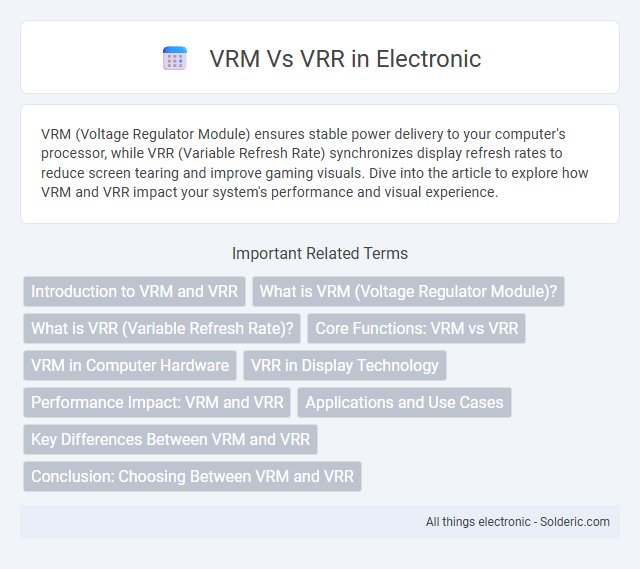VRM (Voltage Regulator Module) ensures stable power delivery to your computer's processor, while VRR (Variable Refresh Rate) synchronizes display refresh rates to reduce screen tearing and improve gaming visuals. Dive into the article to explore how VRM and VRR impact your system's performance and visual experience.
Comparison Table
| Feature | VRM (Voltage Regulator Module) | VRR (Variable Refresh Rate) |
|---|---|---|
| Definition | Hardware module regulating voltage to CPU/GPU. | Display technology varying screen refresh rate dynamically. |
| Purpose | Maintains stable voltage for processor performance and safety. | Reduces screen tearing and input lag for smoother visuals. |
| Use Case | Motherboards, GPUs, and CPUs. | Monitors, laptops, gaming consoles. |
| Key Benefit | Improves power efficiency and component longevity. | Enhances visual experience with adaptive frame syncing. |
| Technology Type | Electrical voltage regulation hardware. | Display protocol feature (e.g., G-SYNC, FreeSync). |
| Examples | Intel VRM, AMD VRM on motherboards. | AMD FreeSync, NVIDIA G-SYNC. |
Introduction to VRM and VRR
VRM (Voltage Regulator Module) ensures your computer's processor and GPU receive stable, precise power, optimizing performance and preventing overheating. VRR (Variable Refresh Rate) technology synchronizes your display's refresh rate with the GPU's output, reducing screen tearing and providing smoother visuals. Understanding the distinct roles of VRM and VRR helps you enhance both hardware reliability and gaming experience.
What is VRM (Voltage Regulator Module)?
VRM (Voltage Regulator Module) is a critical component in computer hardware that ensures a stable and consistent voltage supply to the CPU and other crucial parts. It converts and regulates power from the motherboard to match the specific requirements of the processor, preventing voltage spikes and overheating. Understanding your system's VRM quality can significantly impact performance and longevity, especially during overclocking.
What is VRR (Variable Refresh Rate)?
VRR (Variable Refresh Rate) is a display technology that dynamically adjusts the screen's refresh rate to match the frame rate output of your GPU, reducing screen tearing and stuttering for smoother visuals in gaming and multimedia. Unlike fixed refresh rates, VRR synchronizes the monitor's refresh cycles with the GPU, enhancing motion clarity and responsiveness. Your experience improves with minimal input lag, making VRR essential for a fluid and immersive display performance.
Core Functions: VRM vs VRR
VRM (Voltage Regulator Module) is responsible for delivering clean, stable power to a CPU or GPU by converting voltage from the PSU to the specific levels needed, ensuring efficient energy regulation and preventing hardware damage. VRR (Variable Refresh Rate) technology synchronizes the display's refresh rate with the GPU's frame output, reducing screen tearing and stuttering for smoother visual experiences, especially in gaming. Understanding these core functions helps you optimize both power delivery and display performance for your system.
VRM in Computer Hardware
VRM (Voltage Regulator Module) in computer hardware ensures stable power delivery to the CPU and GPU by converting the power supply's voltage to a usable level. Efficient VRMs help maintain optimal performance and prevent overheating or component damage under heavy workloads. Understanding your system's VRM quality can significantly impact your PC's reliability and overclocking potential.
VRR in Display Technology
Variable Refresh Rate (VRR) enhances display technology by synchronizing the monitor's refresh rate with the frame rate output of the graphics card, reducing screen tearing and stuttering for smoother visuals. Unlike Voltage Regulator Modules (VRM), which manage power delivery to components like CPUs and GPUs, VRR directly impacts gaming and multimedia experiences by delivering fluid motion and improved responsiveness. Your gaming performance and visual quality significantly benefit from displays equipped with VRR technologies such as NVIDIA G-Sync or AMD FreeSync.
Performance Impact: VRM and VRR
VRM (Voltage Regulator Module) ensures stable power delivery to your GPU, directly influencing its overclocking potential and overall performance consistency. VRR (Variable Refresh Rate) technology synchronizes the display's refresh rate with the GPU's frame output, reducing screen tearing and input lag for smoother visuals. Optimizing VRM quality can prevent thermal throttling, while enabling VRR enhances your gaming experience by maintaining fluid frame transitions.
Applications and Use Cases
VRM (Voltage Regulator Module) is essential in computer hardware to maintain stable CPU voltage, ensuring efficient power delivery in high-performance desktops and servers. VRR (Variable Refresh Rate) technology enhances visual experiences in gaming monitors and televisions by synchronizing display refresh rates with graphics card output, reducing screen tearing and input lag. VRM is critical for hardware stability, while VRR significantly improves immersive multimedia and gaming applications.
Key Differences Between VRM and VRR
VRM (Voltage Regulator Module) and VRR (Variable Refresh Rate) serve different purposes in computing and display technology; VRM manages the power supply to the CPU and GPU ensuring stable voltage delivery, while VRR synchronizes the display's refresh rate with the GPU's frame rate to reduce screen tearing. VRM involves hardware components crucial for system stability and efficiency, whereas VRR is a software/firmware feature enhancing visual performance in monitors and TVs. The key difference lies in VRM's role in power regulation versus VRR's function in improving graphical output quality.
Conclusion: Choosing Between VRM and VRR
Choosing between VRM (Voltage Regulator Module) and VRR (Variable Refresh Rate) depends on your device's specific needs: VRM is crucial for stable power delivery to CPUs and GPUs, impacting system performance and longevity, while VRR enhances visual experience by synchronizing refresh rates with frame output to reduce screen tearing and stuttering. Your choice should consider whether priority lies in hardware reliability or smooth, adaptive display performance. Understanding these distinct functions helps optimize either your system's power management or your gaming and multimedia experience.
VRM vs VRR Infographic

 solderic.com
solderic.com